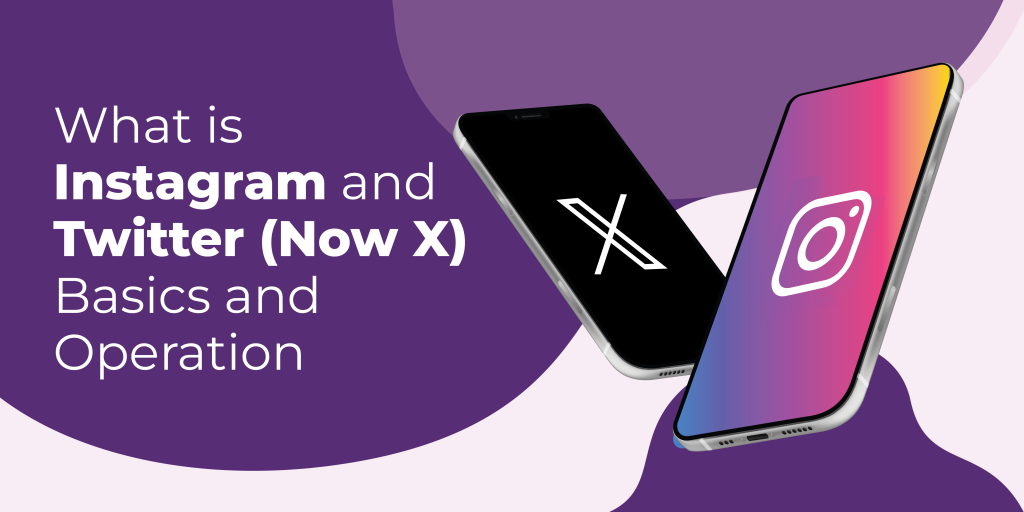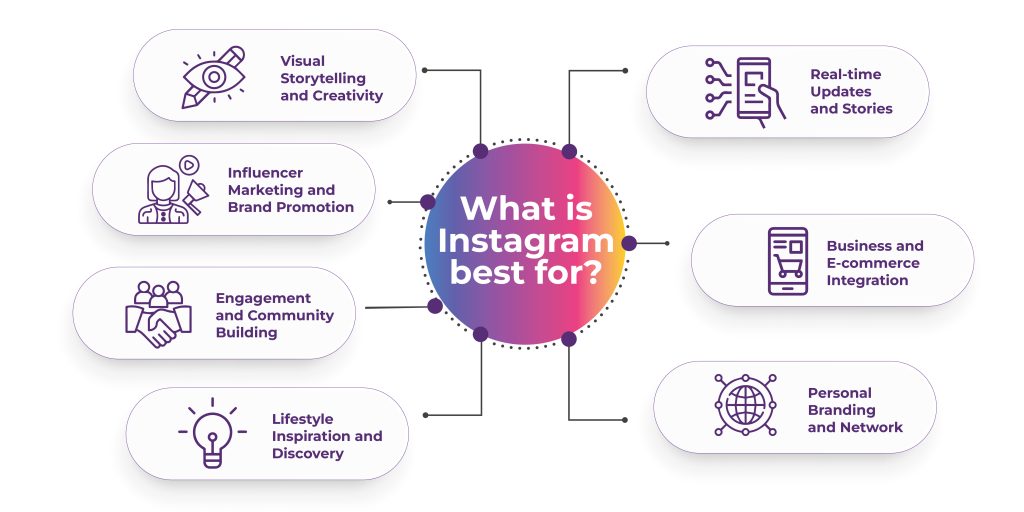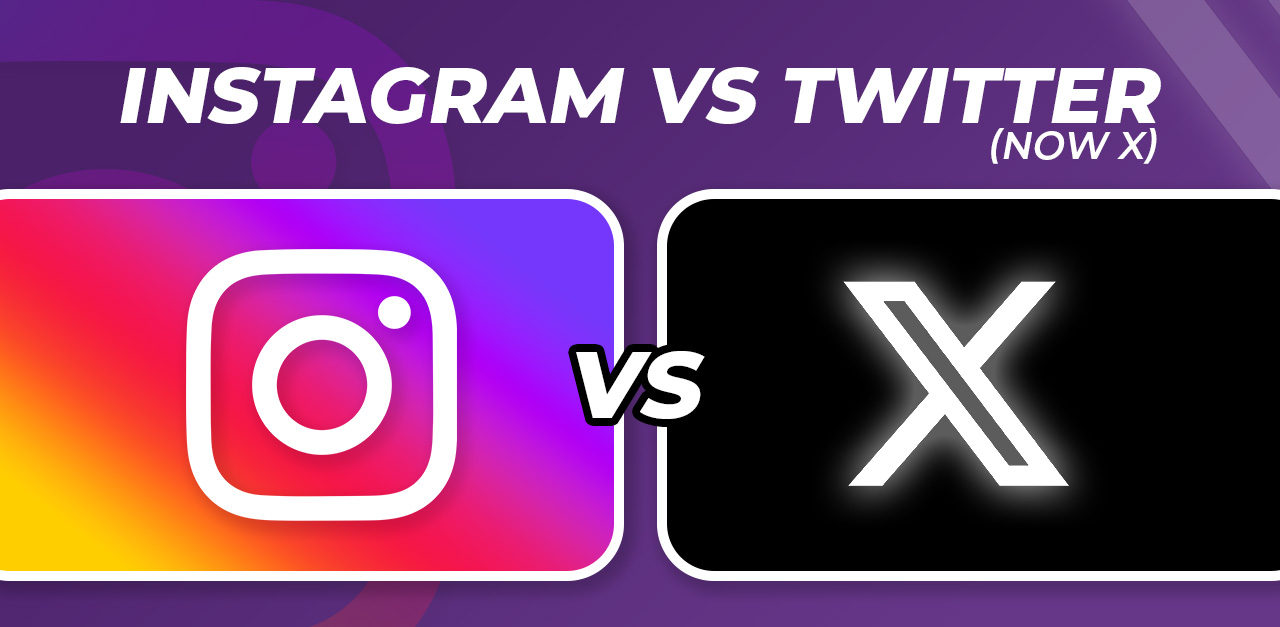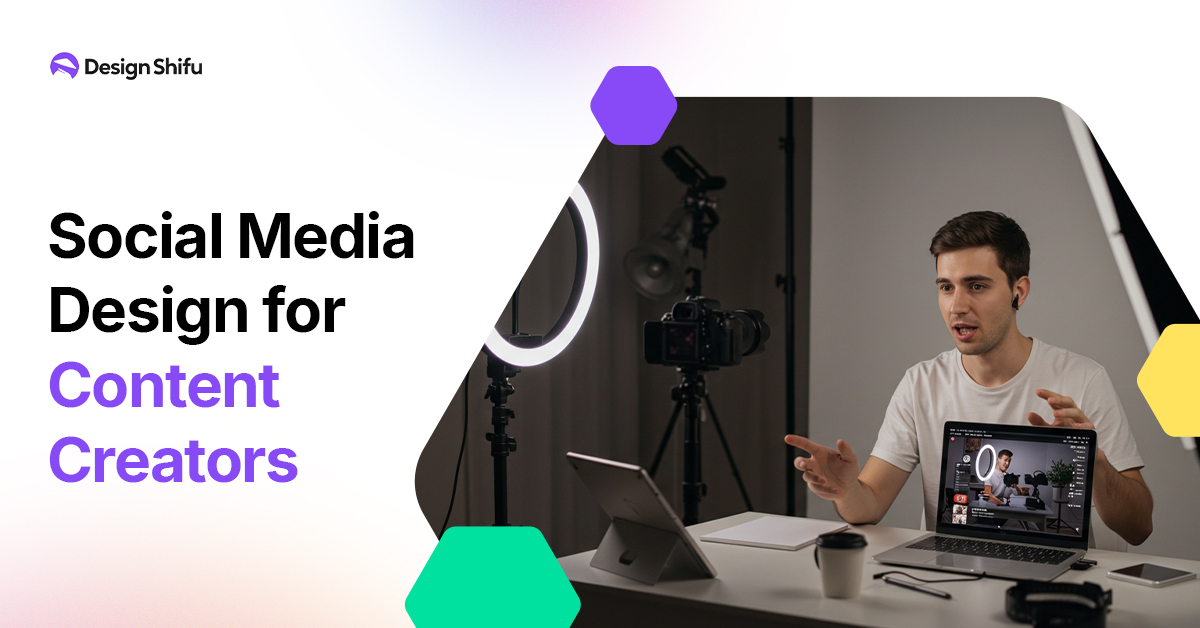When it comes to marketing your business online, having the right platform is essential. Instagram vs Twitter? What’s best for your business type will depend on your target market and objectives. Although Instagram is best for visual storytelling and engaging with younger, visually-oriented consumers, Twitter is best for live updates and participating in discussions with a wide range of demographics.
In this article, we will compare both platforms to assist you in deciding which one is the best for your business.
Ever wondered how a picture or a tweet can reach millions in moments?
Instagram and Twitter (Now X) are the stages for this digital magic.
Instagram, a visual-centric platform, turns everyday moments into a canvas of creativity with photos and videos.
Twitter (Now X), on the other hand, is the pulse of the planet, where now, 25000 (for premium users) characters can spark conversations, movements, and real-time news.
Both platforms are not just social networks; they are global stages where voices are amplified, stories are told, and connections are made, transforming the way we communicate and experience the world.
What is Instagram and Twitter (Now X): Basics and Operation

Instagram: The Visual Storyteller
What is Instagram?
Instagram is a visually driven social media platform that primarily focuses on photo and video sharing. Launched in 2010, it has evolved into a digital space where individuals, brands, and creators share their stories through captivating imagery and engaging videos.
How Does it Operate?
At its core, Instagram allows users to upload photos and videos to their profile. These posts can be edited with various filters and tools to enhance their appeal. Users can follow other accounts, like, comment on, and share posts.
Stories and Reels: A key feature is ‘Stories’, which lets users post images or videos that disappear after 24 hours, and ‘Reels’, which allows creating short-form videos, much like TikTok.
IGTV and Live Streaming: For longer video content, there’s IGTV. Instagram also supports live streaming, a popular feature for real-time engagement.
Explore and Hashtags: The Explore page and hashtags help users discover new content and accounts based on their interests.
Instagram’s algorithm prioritizes content based on user engagement, so the more a user interacts with certain types of content, the more they will see similar content.
Twitter (Now X): The Real-time Microblogger
What is Twitter (Now X)?
Twitter (Now X) is a microblogging platform, launched in 2006, known for its brevity and immediacy. It allows users to post ‘tweets’, short messages limited to 25000 (for premium users), making it a go-to platform for quick, real-time updates and discussions.
How Does it Operate?
Twitter (Now X) operates on a feed of tweets from accounts that a user follows. Users can tweet, retweet, like, and reply to tweets.
Hashtags and Trends: Twitter (Now X) popularized the use of hashtags (#), which are used to mark keywords or topics in a tweet. Trends on Twitter (Now X) often reflect real-time changes in what people are talking about worldwide.
Threads and Lists: Users can create ‘threads’ to connect multiple tweets, and ‘lists’ to organize accounts they follow.
Twitter (Now X) Spaces: This is a feature for live audio conversations, similar to Clubhouse, allowing for more in-depth discussions.
Twitter (Now X)’s algorithm also highlights trending topics and recommends tweets based on user interactions and interests.
The Role of Both Platforms
Both Instagram and Twitter (Now X) have transformed the way we communicate and consume information. Instagram’s strength lies in visual storytelling and creating a personal, visually appealing narrative. It’s widely used for lifestyle, fashion, travel, and food content.
Twitter (Now X), with its emphasis on text and real-time updates, excels in news dissemination, commentary, and public discourse. It’s a platform where you can witness and participate in live conversations on diverse topics.
Also Read: 14 Types of Advertising: Effective Methods of Advertising
What is Twitter (Now X) best for?
Twitter (Now X) is a unique social media platform, and it excels in several areas, making it stand out from other platforms. Let’s dive into what Twitter (Now X) is best for:
Real-time Information and News
First and foremost, Twitter (Now X) is the go-to platform for real-time information and news updates. Its design is perfect for quick, concise updates, which is why journalists, news outlets, and even government agencies frequently use it to share information rapidly.
During significant global events, whether they’re political, cultural, or natural disasters, Twitter (Now X) often becomes a primary source for live updates and on-the-ground reporting. It’s where you can see news unfold in real time, often before it hits the mainstream media.
Public Discourse and Debates
Twitter (Now X) is also a hub for public discourse and debates.
The platform’s open nature encourages discussions and exchanges of views on a wide range of topics, from politics and social issues to science and technology.
Users can participate in these conversations, share their opinions, or just observe different perspectives from around the globe. This dynamic makes Twitter (Now X) a vibrant space for intellectual engagement and societal debates.
To Establish a Network and Professional Development
Another area where Twitter (Now X) excels is in networking and professional development. Many professionals use Twitter (Now X) to connect with peers, industry leaders, and potential collaborators.
It’s a platform where you can easily reach out to experts in your field, join conversations relevant to your profession, and stay updated on industry news and trends. For many, Twitter (Now X) serves as a digital networking event where opportunities and connections are just a tweet away.
Brand Engagement and Customer Service
For businesses and brands, Twitter (Now X) is a powerful tool for engagement and customer service. Many companies use Twitter (Now X) to communicate with their customers, address their concerns, and provide support.
The platform’s immediate nature allows for quick responses, which is crucial for effective customer service. Additionally, brands can use Twitter (Now X) to engage with their audience, run marketing campaigns, and even handle crisis communication.
Entertainment and Pop Culture
Twitter (Now X) is also a key player in the entertainment and pop culture spheres. Celebrities, artists, and creators use Twitter (Now X) to connect with their fans, share updates, and promote their work.
It’s a place where fans can directly interact with their favorite stars, which adds a personal touch that’s hard to find on other platforms. Moreover, Twitter (Now X) often amplifies viral content, memes, and trends, making it a central platform for what’s currently popular or under discussion in the world of entertainment.
Personal Expression and Creativity
Lastly, Twitter (Now X) is a platform for personal expression and creativity. With its concise format, Twitter (Now X) challenges users to be creative and thoughtful with their words.
It’s a space where you can share your thoughts, write mini-threads on topics you’re passionate about, or just express yourself in creative ways. The character limit, which might seem restrictive, actually encourages brevity and clarity, often leading to impactful and memorable content.
What is Instagram best for?

Instagram, a powerhouse in the world of social media, has carved out a unique space for itself. Let’s explore what Instagram is best for, highlighting its distinct advantages and uses.
Visual Storytelling and Creativity
At its heart, Instagram is a platform for visual storytelling. It allows users to share their lives, experiences, and creative expressions through photos and videos.
This visual focus makes it an ideal space for photographers, artists, designers, and anyone looking to share their work or life aesthetically.
The platform’s various tools, like filters and editing options, encourage creativity, enabling users to enhance their photos and videos to tell their stories more compellingly.
Influencer Marketing and Brand Promotion
Instagram has become a key player in influencer marketing and brand promotion. Its visually oriented format is perfect for showcasing products and lifestyles, making it a favorite among brands and advertisers.
Influencers and celebrities use the platform to promote products and services to their followers, leveraging their reach and engagement for marketing. Brands, big and small, utilize Instagram to build their image, launch new products, and connect with customers through visually appealing content.
Want to take your brand to the next level with Instagram influencer marketing? Design Shifu is your perfect partner for creating eye-catching visuals that influencers and celebrities can showcase.
From stunning digital print designs to edgy merchandise, we make sure your brand stands out in the Instagram world. With our help, your products won’t just be promoted; they’ll be desired. Our rapid turnaround, unlimited revisions, and comprehensive design solutions, including print and merchandise design, ensure your brand captures attention. Plus, with our transparent flat-rate pricing, you get exceptional value.
Subscribe to Design Shifu now, and let’s make your brand the talk of Instagram!”
Engagement and Community Building
Instagram’s strength also lies in its ability to foster engagement and build communities. Users can interact through likes, comments, and direct messages, creating a space for conversations and connections.
Hashtags and geotags further facilitate community building by allowing users to discover and engage with content related to specific topics or locations. This sense of community is vital for niche interests and groups, providing a platform to share content and connect with like-minded individuals.
Lifestyle Inspiration and Discovery
Instagram is a treasure house of lifestyle inspiration. Whether it’s fashion, travel, food, fitness, or any other interest, there’s no shortage of content to discover. Users follow accounts that align with their interests, finding inspiration and ideas daily.
This aspect of Instagram makes it a go-to platform for those seeking lifestyle tips, travel destinations, culinary adventures, or fitness motivation.
Real-time Updates and Stories
The introduction of Instagram Stories added a new dimension to the platform – real-time updates. Users share moments from their day that disappear after 24 hours, offering a more spontaneous and less curated content form.
This feature, along with live streaming, allows for real-time engagement with followers, making the platform more dynamic and immediate.
Business and E-commerce Integration
Instagram has expanded its capabilities to include business tools and e-commerce integration. Businesses can set up shop on Instagram, tag products in posts, and sell directly through the app.
These features provide a seamless shopping experience for users and a valuable selling tool for businesses. It’s a significant development for retail brands and small entrepreneurs alike, offering a direct and visually engaging way to reach customers.
Personal Branding and Network
Finally, Instagram is an excellent platform for personal branding and networking. Professionals, artists, and creators use it to showcase their work, build their brand, and connect with peers, collaborators, and potential employers. The platform’s visual nature helps individuals create a strong and memorable personal brand identity.
Who is the Audience – Who uses Instagram and Twitter (Now X)?
Understanding the audience of Instagram and Twitter (Now X) is key to effectively utilizing these platforms, whether for personal use, branding, or marketing.
Both platforms cater to a wide range of users, but they have distinct audience characteristics.
Instagram Audience
Younger Demographics: Instagram’s user base skews younger, with a significant portion of its audience being millennials and Gen Z. It’s popular among people in the 18-34 age range, making it a go-to platform for brands targeting younger consumers.
Lifestyle and Visual Content Enthusiasts: Instagram appeals to users interested in lifestyle, fashion, travel, food, art, and photography. Its visually-driven format is perfect for those who appreciate aesthetics and creative content.
Influencers and Celebrities: This platform is a hotspot for influencers and celebrities. Users follow them for lifestyle inspiration, trends, and entertainment.
Brands and Businesses: With its visually appealing format and a younger audience, many brands and businesses use Instagram for marketing. It’s especially popular among fashion, beauty, travel, and lifestyle brands.
Content Creators and Artists: Creative professionals like photographers, artists, designers, and videographers use Instagram to showcase their portfolios and reach a broader audience.
Twitter (Now X) Audience
Diverse Age Groups: Twitter (Now X) has a more diverse age distribution, with significant usage across different age groups, although it’s particularly popular among users in their 20s and 30s.
News and Information Seekers: Users who are interested in staying updated with the latest news, trends, and current events tend to gravitate towards Twitter (Now X). It’s known for real-time updates and discussions on a wide range of topics.
Professionals and Industry Experts: Twitter (Now X) is used by professionals, academics, journalists, and experts in various fields to share their thoughts, network, and stay updated in their respective industries.
Activists and Political Enthusiasts: The platform is popular among activists, political commentators, and those interested in civic engagement due to its nature of fostering public discourse.
Brands Focused on Engagement and Customer Service: Businesses use Twitter (Now X) for customer service and engagement, leveraging its real-time communication capabilities.
Writers and Thought Leaders: Given its text-based nature, Twitter (Now X) is a favorite among writers, bloggers, and thought leaders who share insights, stories, and commentary.
Side-by-Side Comparison of Instagram vs. Twitter (Now X)
These differences can be seen in a side-by-side comparison of Instagram and Twitter (Now X):
| Aspect | Twitter (Now X) | |
| Primary Use | Visual sharing platform focusing on photos and videos. | Microblogging platform for sharing short text posts (tweets). |
| Content Type | Heavily visual with emphasis on images and videos. | Text-focused with support for images, videos, and links. |
| Audience | Mostly younger (Millennials and Gen Z). Popular with lifestyle enthusiasts, creative professionals, and influencers. | Broader age range, including professionals, journalists, activists, and those interested in news and real-time updates. |
| User Interaction | Likes, comments, direct messaging, and stories replies. | Tweets, retweets, replies, likes, and direct messaging. |
| Engagement Style | More personal and lifestyle-oriented. Emphasis on aesthetics and storytelling. | More public and conversational. Suited for discussions, debates, and real-time updates. |
| Key Features | Stories, Reels, IGTV, filters, and shopping features. | Tweet threads, lists, trending topics, hashtags, and Twitter (Now X) Spaces. |
| Content Lifespan | Longer lifespan for posts. Evergreen content is common. | Shorter lifespan. Content is more about immediacy and real-time relevance. |
| Business Use | Strong for visual branding, influencer partnerships, and product showcases. | Strong for customer service, brand engagement, and real-time marketing campaigns. |
| Discovery | Explore page and hashtags for discovering new content and accounts. | Hashtags, trends, and algorithmic recommendations for content discovery. |
| Algorithm | Prioritizes content based on user engagement and relationships. | Focuses on recency and relevance, as well as user engagement. |
| Advertisement | Highly visual ads integrated into the feed and stories. | Text-based and visual ads; more integrated into the flow of tweets. |
| Analytics | Instagram Insights for tracking engagement and audience demographics. | Twitter (Now X) Analytics for monitoring tweet performance and audience insights. |
| Content Creation | More emphasis on high-quality, curated visuals. | More spontaneous and text-oriented; suitable for quick updates. |
| Community development | Communities built around shared interests and aesthetics. | Communities formed around topics, news, and shared opinions. |
What’s Better for Your Type of Business?
Your business, target audience, and marketing goals will heavily influence the choice between Instagram and Twitter (Now X).
Here are some examples of which platforms might be best for different types of businesses:
Businesses Best Suited for Instagram
Fashion Brands: Instagram’s visual-centric platform is ideal for fashion brands. For example, Zara uses Instagram to showcase its latest collections through high-quality images and videos, tapping into the platform’s huge base of fashion enthusiasts.
Food and Beverage Companies: Businesses like Starbucks excel on Instagram by sharing appealing images of their products, coupled with engaging storytelling and seasonal marketing.
Travel and Hospitality Services: Companies like Airbnb utilize Instagram to share breathtaking travel photos from around the world, inspiring users and driving bookings.
Beauty and Cosmetics Brands: Sephora, for instance, leverages Instagram to display its products through tutorials, user-generated content, and influencer partnerships.
Fitness and Wellness Brands: Gymshark uses Instagram to share fitness tips, showcase their apparel through influencers, and build a community around fitness and wellness.
Businesses Best Suited for Twitter (Now X)
News Outlets and Publications: The New York Times uses Twitter (Now X) effectively to share breaking news, articles, and updates, engaging with readers in real time.
Tech Companies: Companies like Microsoft and Google use Twitter (Now X) for announcements, tech news, and customer service, taking advantage of the platform’s real-time communication capabilities.
Consumer Brands with a Focus on Customer Service: Brands like JetBlue Airways utilize Twitter (Now X) as a tool for quick customer service responses, addressing customer concerns and questions promptly.
Entertainment and Media Companies: Netflix, for example, uses Twitter (Now X) to engage with audiences through content announcements, teasers, and interactive posts, building excitement and engagement around their shows and movies.
Financial Services: Firms like Goldman Sachs use Twitter (Now X) to share market insights, company news, and thought leadership content, targeting a more professional audience.
Challenges Businesses Face on Instagram
As businesses compete with millions of Instagram users, deliver high-quality content consistently, and navigate ever-changing algorithms, they face distinct challenges.
Additionally, engaging meaningfully with followers and effectively measuring the impact of Instagram initiatives adds to the complexity, making it a demanding yet rewarding platform for businesses.
Challenges include:
High Competition: With millions of active businesses on the platform, standing out on Instagram can be difficult. The saturated market means businesses must create exceptionally engaging and unique content to capture users’ attention.
Constant Need for High-Quality Visual Content: Instagram’s visually-driven nature requires a steady stream of high-quality images and videos, which can be resource-intensive in terms of time, creativity, and budget.
Algorithm Changes: Instagram’s ever-changing algorithm can affect post visibility and engagement. Keeping up with these changes and adapting content strategy accordingly can be challenging.
Building and Maintaining Engagement: Garnering a significant following is just the first step. Continuously engaging with the audience through comments, stories, and direct messages requires time and effort.
Measuring ROI: For businesses, especially those not directly selling products on the platform, measuring the return on investment (ROI) from Instagram marketing efforts can be tricky.
Ad Costs and Management: Running effective Instagram ad campaigns involves understanding the platform’s advertising system, which can be complex, and ad costs can be high for competitive industries.
Challenges Businesses Face on Twitter (Now X)
In a real-time, high-volume environment like Twitter (Now X), businesses struggle to craft impactful, concise messages. Managing customer interactions, staying current with trends, and maintaining a consistent brand voice amidst the rapid flow of information on the platform can prove challenging.
In this dynamic space, strategic agility and adaptability are also essential to ensuring visibility and calculating ROI.
Below are a few challenges:
Limited Character Count: The limited character can be restrictive, especially for conveying complex messages or detailed information about products or services. This can now be resolved by subscribing to X premium.
Real-Time Engagement Demand: Twitter (Now X)’s real-time nature means businesses need to constantly monitor their accounts for customer queries, complaints, or trending topics, requiring dedicated resources.
Maintaining Brand Voice and Reputation: With the ease of sharing and commenting, businesses need to be cautious about maintaining a consistent brand voice and quickly addressing any negative feedback or PR crises.
Content Overload and Visibility: The fast-paced environment of Twitter (Now X) can lead to content overload, making it challenging for businesses’ tweets to be seen and engaged with, especially without frequent posting.
Trolls and Negative Publicity: Twitter (Now X) can be a breeding ground for trolls and negative comments. Managing and responding to these in a way that aligns with the brand’s image can be a delicate task.
ROI Measurement: Similar to Instagram, quantifying the ROI on Twitter (Now X), especially for non-paid engagements, can be challenging, requiring businesses to look at long-term engagement and brand awareness metrics.
Frequently Asked Questions (FAQs):
Does Instagram still matter?
Yes, Instagram remains highly relevant, especially for visual content and engaging younger audiences.
How does the market share of Twitter (Now X) and Instagram compare in the Social Media market?
Instagram generally has a larger market share, particularly in user engagement and time spent on the platform, compared to Twitter (Now X).
What is the difference between Instagram, Snapchat, and Twitter (Now X)?
Instagram focuses on visual content sharing; Snapchat is known for ephemeral, disappearing content and playful filters; Twitter (Now X) is a microblogging platform for real-time updates and concise text posts.
How many customers are acquired by Twitter (Now X) and Instagram in the Social Media segment?
Exact figures vary, but Instagram typically sees higher growth in user acquisition compared to Twitter (Now X), reflecting its broader appeal.
How can I increase my reach on Instagram?
Post consistently high-quality content, use relevant hashtags, engage with your audience, and utilize Instagram’s features like Stories and Reels.





